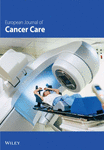Skin reactions during radiotherapy for breast cancer: the use and impact of topical agents and dressings
Abstract
Radiation skin reactions occur in the majority of cases of patients undergoing radiotherapy for breast cancer with varying degrees of severity. Guidelines for skin care and for the use of topical agents and dressings have developed over the years of practice but there is little empirical evidence on which to base a decision for best practice. This paper describes the incidence of radiation skin reactions in a sample of 126 women treated for breast cancer post-lumpectomy. The results show that by the end of whole breast irradiation between 4–8% of patients will have no reaction and less than 10% will have moist desquamation as measured by the RTOG acute scoring system. The majority of patients did not require application of a topical agent during the treatment period. Statistical analysis of relationships between the severity of radiation skin reaction and the use of topical agents found no support for additional healing or preventative benefit. However, these topical agents were found to promote comfort. The use of Fixomull™ as a protector and potential preventive measure for moist desquamation is described.




